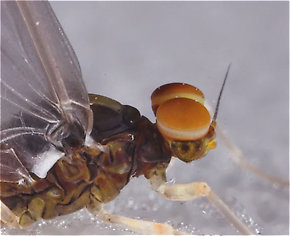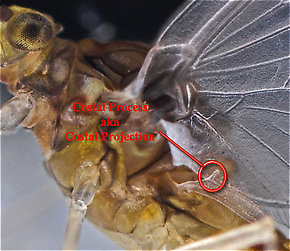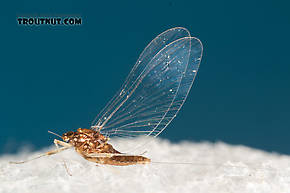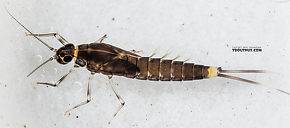Blog & Latest Updates
Fly Fishing Articles
Insects by Common Name


Little Western Iron-blue Quills
Scientific Names
| Match | Scientific Name |
| Acentrella turbida | |
| Labiobaetis propinquus | |
| Diphetor hageni |
Like most common names, "Little Western Iron-blue Quill" can refer to more than one taxon. They're previewed below, along with 2 specimens. For more detail click through to the scientific names.
Mayfly Species Acentrella turbida
These are often called Little Western Iron-blue Quills.
These tiny mayflies were once known by the names Pseudocloeon carolina in the East and Pseudocloeon turbidum in the West. They are now considered synonymous. With the new species name turbida, these mayflies were also moved to the genus Acentrella. The combining of these two species has made turbida's distribution trans-continental. In places their numbers compensate for their small size and make for excellent hatches.
In the West, turbida is more variable in size and appearance than its eastern iteration, in keeping with the large and varied regions it inhabits. It can run as small as 3.5 mm and as large as 5 mm, the larger sizes tending to be more brownish. It is often confused with the smaller broods of Diphetor hageni, but its conical mesonotal projection (Conical mesonotal projection: small cone shaped spike sticking up from the top and front part of the middle thorax segment.), lack of hind-wings, exaggerated turbinate ( Turbinate: Shaped like a top or elevated on a stalk; usually refers to the eyes of some adult male Baetidae mayflies which are wider near the tip than at the base.) eyes (hence its name) and stockier build help to differentiate it.
Turbinate: Shaped like a top or elevated on a stalk; usually refers to the eyes of some adult male Baetidae mayflies which are wider near the tip than at the base.) eyes (hence its name) and stockier build help to differentiate it.
They are often found on the water with a mix of other Baetidae mayflies, making for very challenging fishing.
In the West, turbida is more variable in size and appearance than its eastern iteration, in keeping with the large and varied regions it inhabits. It can run as small as 3.5 mm and as large as 5 mm, the larger sizes tending to be more brownish. It is often confused with the smaller broods of Diphetor hageni, but its conical mesonotal projection (Conical mesonotal projection: small cone shaped spike sticking up from the top and front part of the middle thorax segment.), lack of hind-wings, exaggerated turbinate (

This male Baetidae dun has slightly turbinate eyes.
They are often found on the water with a mix of other Baetidae mayflies, making for very challenging fishing.
See 3 more specimens...
Mayfly Species Labiobaetis propinquus
These are sometimes called Little Western Iron-blue Quills.
This species was previously known as Baetis propinquus, a name from older nomenclatures and angling literature familiar to many western anglers. Prior to its current listing, it did a brief stint in the genus Pseudocloeon. The irony is that though this species has hind wings, it was the last species remaining in Pseudocloeon (before the genus recent Nearctic taxonomic demise) which was best known for its species lacking hind wings as an identifying character.
Though it has a national distribution its most important hatches occur in the West, usually hatching between the larger broods of Baetis tricaudatus. Western anglers experiencing a hatch can easily confuse them with the larger Baetis bicaudatus as both nymphs appear similar with only two tails. Besides size, the adults can be separated from bicaudatus (with the help of a little magnification) because L. propinquus lacks acute costal projections ( Costal projection: A bump or point sticking up from the front margin of an insect's wing, usually the rear wing of certain mayflies. It is sometimes called a costal process.) on its tiny hind wings. Conversely, the presence of hind wings and lack of conical mesonotal projections (Conical mesonotal projection: small cone shaped spike sticking up from the top and front part of the middle thorax segment.) makes them easy to tell from the more common and equally tiny Acentrella turbida.
Costal projection: A bump or point sticking up from the front margin of an insect's wing, usually the rear wing of certain mayflies. It is sometimes called a costal process.) on its tiny hind wings. Conversely, the presence of hind wings and lack of conical mesonotal projections (Conical mesonotal projection: small cone shaped spike sticking up from the top and front part of the middle thorax segment.) makes them easy to tell from the more common and equally tiny Acentrella turbida.
Though it has a national distribution its most important hatches occur in the West, usually hatching between the larger broods of Baetis tricaudatus. Western anglers experiencing a hatch can easily confuse them with the larger Baetis bicaudatus as both nymphs appear similar with only two tails. Besides size, the adults can be separated from bicaudatus (with the help of a little magnification) because L. propinquus lacks acute costal projections (

The costal projection of a Baetidae dun.
Mayfly Species Diphetor hageni
These are very rarely called Little Western Iron-blue Quills.
This is one of the most important species of the Baetidae family. Previously known as Baetis parvus in the West and its synonym (Synonym: A former name of a taxon, usually a species. Entomologists frequently discover that two insects originally described as different species are one in the same, and they drop one of the names. The dropped name is said to be a synonym of the remaining name. These changes take a while to trickle into the common knowledge of anglers; for example, Baetis vagans is now a synonym of Baetis tricaudatus.) Baetis devinctus in the East, it is distributed across the country but most of its fame comes from excellent hatches in the West. Prior to all the species being combined with Baetis tricaudatus, most angling literature considered it the most populous and widespread western species of the Baetidae family.
Dorsal (Dorsal: Top.) abdominal markings on the nymphs used to differentiate the species in these older works have since proved unreliable. The easiest way to tell them apart from B. tricaudatus is their lack of gills on the first abdominal segment. Telling adults apart is equally tough. Duns of D. hageni are typically a little smaller, but their bodies can also be olive, brownish olive and even two toned with thoraxes a shade of brown or tan with paler olivacious abdomens.
Diphetor hageni has two former names used in angling literature, Baetis parvus in the West and Baetis divinctus in the East.
Dorsal (Dorsal: Top.) abdominal markings on the nymphs used to differentiate the species in these older works have since proved unreliable. The easiest way to tell them apart from B. tricaudatus is their lack of gills on the first abdominal segment. Telling adults apart is equally tough. Duns of D. hageni are typically a little smaller, but their bodies can also be olive, brownish olive and even two toned with thoraxes a shade of brown or tan with paler olivacious abdomens.
Diphetor hageni has two former names used in angling literature, Baetis parvus in the West and Baetis divinctus in the East.
Top 10 Fly Hatches
Top Gift Shop Designs
Eat mayflies.
Top Insect Specimens
Miscellaneous Sites
Troutnut.com is copyright © 2004-2024 Jason
Neuswanger (email Jason). See my FAQ for information about use of my images.
 privacy policy
privacy policy


